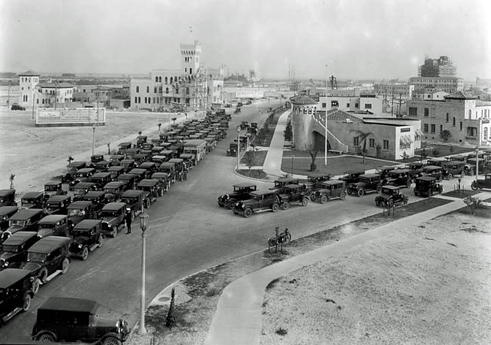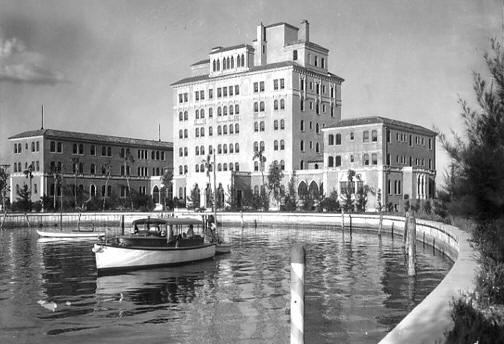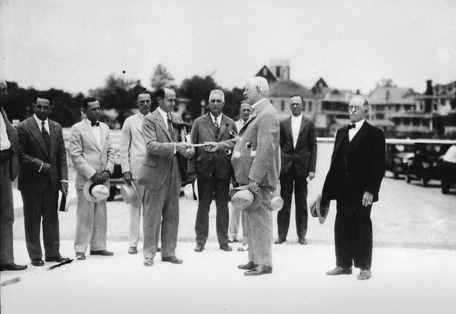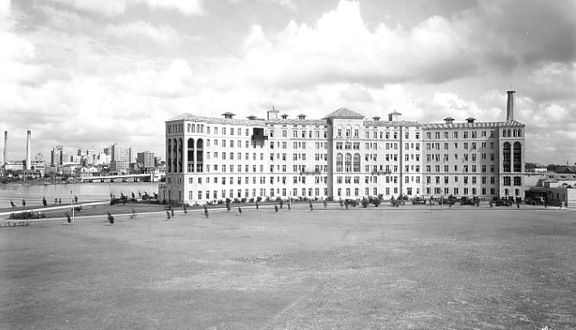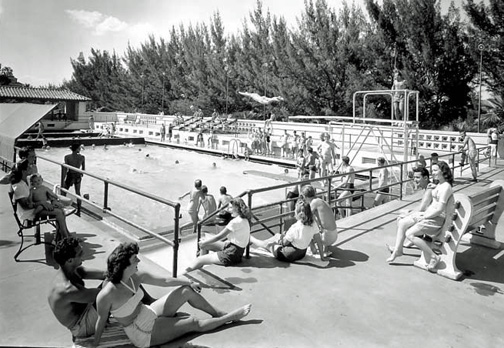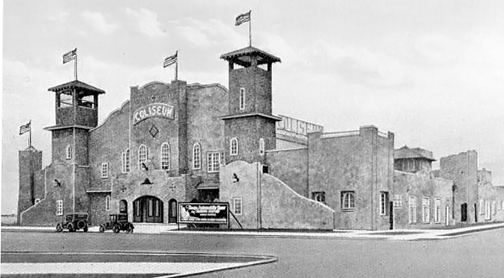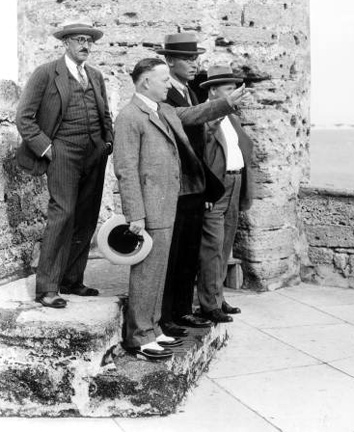|
Stone & Webster
Continue Davis's Vision
"Stone & Webster continued construction on Davis Islands in late 1926, with attention focused primarily on infrastructure. They moved their Tampa offices from 101 Tampa Street in downtown to Davis Islands, possibly as a show of support for the Islands' business district. Their first Islands office, in 1927, was located on the corner of Columbia and Barbados. By 1930, however, they abandoned the Islands altogether, a harbinger of things to come." From "In Search of David Paul Davis" by Rodney Kite-Powell |
|
|
1926 traffic at
Davis Blvd. and Aegean
after the Dixie Tennis Tournament. |
|
|
Davis Islands Awarded Validation for Davis's determined plan came in 1927 when the American Association of City Planners awarded its first prize to Davis Islands. The Association pointed favorably to the layout, which, embraced sixty streets, representing a total of twenty-seven miles of broad, curving boulevards sixty to 100 feet in width, and several miles of picturesque, winding waterways. It provided for nearly eleven miles of waterfront locations and a large amount of golf course frontage for fine homes. It was so planned that not any residential lot in the entire property would be more than 500 yards from the water. From "In Search of David Paul Davis" by Rodney Kite-Powell |
|
| Though he never saw his creation to completion, Davis's dream of a model community became reality. The award was as much for Davis's visionary planning as for Stone & Webster's continued execution, referred to in the last sentence of the Tampa Daily Times, October 20, 1971; "The development of these features has continued throughout the property with provision of all utilities enjoyed by the most exclusive residential communities." From "In Search of David Paul Davis" by Rodney Kite-Powell | |
|
|
Changes in the Dream
With the transfer of ownership from Davis's D. P. Davis Properties to Stone & Webster's Davis Islands Incorporated came increased flexibility in the design restrictions. Davis Islands Incorporated continued construction on the Islands for the benefit of both private and business residents. The firm also pursued the internal improvements included in Davis's original plans, which were necessary for the smooth flow of the increasing automobile traffic. The permanent bridge leading to Davis Islands was dedicated in a ceremony featuring Tampa Mayor D. B. McKay and Howard G. Philbrook, president of Davis Islands Incorporated, on May 16, 1928. It took nearly eighteen months to complete the bridge, with a portion of the time spent fighting an injunction by Patrick and Euphemia Kelliher, who claimed the bridge infringed on the riparian (underwater) rights of their property at 105 Bay Street. From "In Search of David Paul Davis" by Rodney Kite-Powell |
|
1928 Davis Islands Bridge. Photo from the Burgert Bros. collection at the Tampa-Hillsborough County Public Library. |
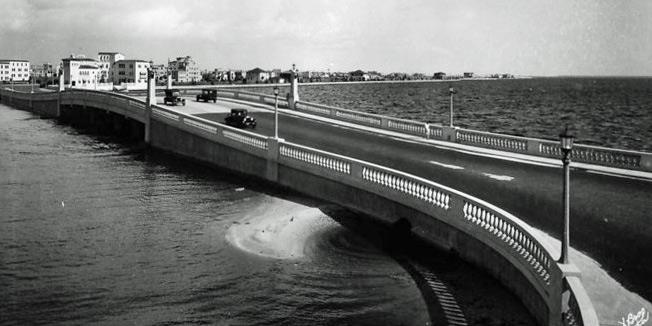 |
|
|
1928 Tampa Municipal Hospital (Now Tampa General Hospital.) Photo from the Burgert Bros. collection at the Tampa-Hillsborough County Public Library. |
| Davis Islands
Incorporated kept another of Davis's promises, in 1929, with completion
of the Davis Islands Pool. Located on the corner of Columbia Drive and
Bosphorous Avenue, the $75,000 swimming pool represented one of the last
large-scale projects funded by Davis Islands Incorporated. Davis
Islands Incorporated continued to advertise the virtues of visiting and
living on the Islands, but a reduced marketing budget directed the
message to a different target audience.
From "In Search of David Paul Davis" by Rodney Kite-Powell Davis Islands
Swimming Pool in 1947 |
|
|
|
Davis Islands Coliseum, 1928. Photo from the Burgert Bros. collection at the Tampa-Hillsborough County Public Library. |
| The year 1930 saw
the end of the old Davis marketing machine, when the administration
offices moved from 32 Davis Boulevard into space on the second floor
of the Bay Isle Building--the offices recently vacated by Stone &
Webster. The Davis Boulevard office became the Seaborn Day School that
same year. Real estate promotion in Tampa, and across Florida,
continued its free fall in the latter part of the 1920s. The
final blow, of course, was the stock market crash on October 29, 1929.
The rest of the country was simply joining Florida in economic
depression.
David Davis was among the most notable casualties of Florida's real estate boom and bust. Countless subdivisions were left in its wake, often just paved streets leading to nowhere. Eventually all of Davis' properties would prove successful. In Miami, his Commercial Biltmore development has seen new life in the form of the city's fashionable Design District. Davis Islands has continued to be a popular and profitable address with 75 some homes selling for a million dollars or more. The same holds true for Davis Shores, though it did not reach completion until the 1950s. From "In Search of David Paul Davis" by Rodney Kite-Powell Davis with St. Augustine investors, 1926
Photo from the Burgert Bros.
collection
|
|
| Davis' family
experienced the usual mix of success and failure typical to most
Americans. His brothers worked with him on Davis Islands, with Milton
carrying the Davis name to Fort Myers and Havana, Cuba. The brothers
eventually returned to Davis Islands in retirement, living out their
golden years on their big brother's island. Their sister, Elizabeth Hodgson, remained in Tampa with her husband until 1949. George Hodgson, David's brother-in-law, worked in a variety of capacities for Davis Properties, Davis Islands Incorporated and the Davis Islands Garage. Eventually, the Hodgsons left Tampa, retiring in Bradenton Beach, Florida. David Davis' sons, George Riley Davis, II and David Paul Davis, Jr. were both sent to live with relatives in California following their father's death. The junior Davis, came to Tampa in 1953 to visit family, including his aunt and uncles, and was thirty-one years old at the time. He also wanted to see Davis Islands for the first time in twenty-seven years. Davis only had faint memories of his father and his developments, saying, "It is like trying to piece together the hazy fragments of a vague dream. Without knowing it, David Davis, Jr. described the burden that weighs on all of his father's biographers. The legends surrounding his life and death are a tangle of public relations stories, selective memory, honest mistakes and outright lies. Sorting through it all and piecing together those hazy fragments into a coherent history is difficult indeed. Once complete, the substance of the man and the impact he made on his native state are a far cry from a vague dream. --Rodney Kite-Powell
|
|
D.P. Davis & His Islands | Davis' Opposition | Davis' Death & Lucille Zehring | Davis Islands Development After D.P. Davis
